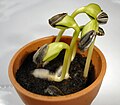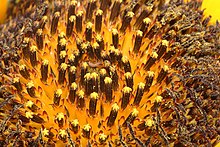We had sunflower planted at home and I am glad it grows well and give some blooms of flowers.I like it ...so for now I want to share with you what is sunflower is all about? thanks and keep in touch.
| Bumble bee sampling nectar | |||
| Heads sold as snacks in China | A sunflower in New Zealand |
Sunflowers (Helianthus annuus) are annual plants native to the Americas, that possess a large inflorescence (flowering head).
What is usually called the flower is actually a head (formally composite flower) of numerous florets (small flowers) crowded together. The outer florets are the sterile ray florets and can be yellow, maroon, orange, or other colors. The florets inside the circular head are called disc florets, which mature into seeds.
The florets within the sunflower's cluster are arranged in a spiral pattern. Typically each floret is oriented toward the next by approximately the golden angle, 137.5°, producing a pattern of interconnecting spirals where the number of left spirals and the number of right spirals are successive Fibonacci numbers. Typically, there are 34 spirals in one direction and 55 in the other; on a very large sunflower there could be 89 in one direction and 144 in the other.This pattern produces the most efficient packing of seeds within the flower head.
Sunflowers in the bud stage exhibit heliotropism. At sunrise, the faces of most sunflowers are turned towards the east. Over the course of the day, they follow the sun from east to west, while at night they return to an eastward orientation. This motion is performed by motor cells in the pulvinus, a flexible segment of the stem just below the bud. As the bud stage ends, the stem stiffens and the blooming stage is reached.
Sunflowers in their blooming stage lose their heliotropic capacity. The stem becomes "frozen", typically in an eastward orientation.[citation needed] The stem and leaves lose their green color.
The wild sunflower typically does not turn toward the sun; its flowering heads may face many directions when mature. However, the leaves typically exhibit some heliotropism.
The sunflower is native to the Central Americas. The evidence thus far is that it was first domesticated in Mexico, by at least 2600 BC.It may have been domesticated a second time in the middle Mississippi Valley, or been introduced there from Mexico at an early date, as maize was. The earliest known examples of a fully domesticated sunflower north of Mexico have been found in Tennessee and date to around 2300 BC. Many indigenous American peoples used the sunflower as the symbol of their solar deity, including the Aztecs and the Otomi of Mexico and the Incas in South America. Francisco Pizarro was the first European to encounter the sunflower in Tahuantinsuyo, Peru. Gold images of the flower, as well as seeds, were taken back to Spain early in the 16th century. Some researchers argue that the Spaniards tried to suppress cultivation of the sunflower because of its association with solar religion and warfare.
During the 18th century, the use of sunflower oil became very popular in Europe, particularly with members of the Russian Orthodox Church because sunflower oil was one of the few oils that was not prohibited during Lent.
To grow well, sunflowers need full sun. They grow best in fertile, moist, well-drained soil with a lot of mulch. In commercial planting, seeds are planted 45 cm (1.5 ft) apart and 2.5 cm (1 in) deep. Sunflower "whole seed" (fruit) are sold as a snack food, after roasting in ovens, with or without salt added. Sunflowers can be processed into a peanut butter alternative, Sunbutter. In Germany, it is mixed together with rye flour to make Sonnenblumenkernbrot (literally: sunflower whole seed bread), which is quite popular in German-speaking Europe. It is also sold as food for birds and can be used directly in cooking and salads.
Sunflower oil, extracted from the seeds, is used for cooking, as a carrier oil and to produce margarine and biodiesel, as it is cheaper than olive oil. A range of sunflower varieties exist with differing fatty acid compositions; some 'high oleic' types contain a higher level of healthy monounsaturated fats in their oil than even olive oil.
The cake remaining after the seeds have been processed for oil is used as a livestock feed. Some recently developed cultivars have drooping heads. These cultivars are less attractive to gardeners growing the flowers as ornamental plants, but appeal to farmers, because they reduce bird damage and losses from some plant diseases. Sunflowers also produce latex and are the subject of experiments to improve their suitability as an alternative crop for producing hypoallergenic rubber.
Traditionally, several Native American groups planted sunflowers on the north edges of their gardens as a "fourth sister" to the better known three sisters combination of corn, beans, and squash.Annual species are often planted for their allelopathic properties.
However, for commercial farmers growing commodity crops, the sunflower, like any other unwanted plant, is often considered a weed. Especially in the midwestern USA, wild (perennial) species are often found in corn and soybean fields and can have a negative impact on yields.
Sunflowers may also be used to extract toxic ingredients from soil, such as lead, arsenic and uranium. They were used to remove uranium, cesium-137, and strontium-90 from soil after the Chernobyl disaster (see phytoremediation).
Sunflowers most commonly grow to heights between 1.5 and 3.5 m (8-12 ft). Scientific literature reports from 1567, that a 12-m (40 ft), traditional, single-head, sunflower plant was grown in Padua. The same seed lot grew almost 8 m (26 ft) at other times and places (e.g. Madrid). Much more recent feats (past score years) of over 8 m have been achieved in both Netherlands and Ontario, Canada.
- The sunflower is the state flower of the US state of Kansas, and one of the city flowers of Kitakyushu, Japan.
- The sunflower is often used as a symbol of green ideology, much as the red rose is a symbol of socialism or social democracy. The sunflower is also the symbol of the Vegan Society. During the late nineteenth century, the flower was used as the symbol of the Aesthetic Movement.
- Subject of Van Gogh's most famous still life, Sunflowers (series of paintings)
- The sunflower is the national flower of Ukraine.
- The Maximillian sunflower (Helianthus maximillianii) is one of 38 species of perennial sunflower native to North America. The Land Institute and other breeding programs are currently exploring the potential for these as a perennial seed crop
- The Sunchoke (Jerusalem artichoke or Helianthus tuberosus) is related to the sunflower, another example of perennial sunflower.
- The Mexican sunflower is Tithonia rotundifolia. It is only very distantly related to North American sunflowers.
- False sunflower refers to plants of the genus Heliopsis.









0 comments:
Post a Comment